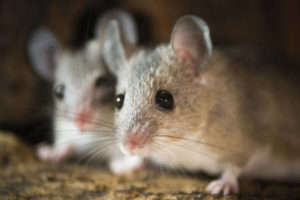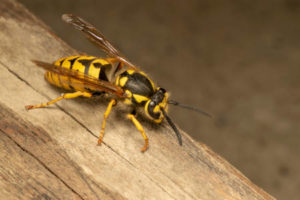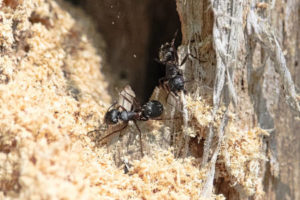What’s the crunching sound in my wall?
By Zachary Ciras on August 12, 2022.
Tap, scratch, crinkle, and crunch… There’s little more annoying in life than a persistent, unreachable noise coming from inside your walls or ceiling. It may be at night or during the day, but the question remains: What is it!? And once the agent of the noise has been determined, how to make it stop?
Let’s explore some of the more common noises you may hear in your attic or ceiling and wall voids, and try to make some sense of them.
What Goes Thump in the Night?
Do you hear a thump, a thud, or a splat? Does this sound occur just before dawn? If so, you may want to consider it flying squirrels. Flying squirrels will be active around the same time as mice, but they hold truer to the timeline. Mice can be seen and heard at any time of day and night, though their biology has determined that the most active time is dawn and dusk. Animals who peak in activity at dawn and dusk are said to be crepuscular. When flying squirrels come back into the attic through their entry hole, it is usually near dawn. Often, they will glide right into the hole and land with a thud. Even though the Northern Flying Squirrel only weighs 2-4oz on average, it when it lands with a full glide worth of force behind it, it can sound a lot louder and larger than it should. Rats and mice tend to have peak activity during the crepuscular times as well, but may be quite active at any time of day or night depending on their needs. Ants, as we’ll discover, are nocturnal insects, and yellow jackets are active during the day. The noises they produce are not thuds or thumps, but fit better into
Other thuds may come from other squirrels such as red squirrels or gray squirrels. These two rodents are diurnal, or more active during daytime hours, however. And gray squirrels don’t just thud. They thrash, bang, bruise, gnaw, and mangle anything they can. Flyers can be noisy little runners, especially when they land, but they are nowhere near as disturbing as gray squirrels. Occasionally, the thump you hear will be from something knocking over an item, but these sounds will not repeat like an animal making the noises would.
Horse Race in the Attic
Red Squirrels weigh about 7 oz, which is twice the weight of many Flying Squirrels. Gray squirrels often come in above one pound. When these squirrels are running circles in your attic, you know it! Although, you may think it’s a thoroughbred competition, not squirrels. One of the reasons things sound so much larger is that your attic, especially if something is right at the drywall level or vibrating the joists, acts like an oversized tom-tom drum, vibrating, reverberating, and amplifying every percussion. That’s why a mouse will often sound like a squirrel, and a squirrel will often sound like a horse.
Tap, Tap, Pitter Patter, Scratch

two mice in the nest
Less than a thud, but certainly more than the wind blowing could be the walking, playing, eating, and scratching of animals. Besides the time of day or night that these noises are heard, this is the other main question we ask concerned homeowners about the noises. “what does it sound like exactly?” Being able to demonstrate the sounds is beneficial, but without the requisite onomatopoetic literary talents for each subjective noise, we are left with less explicit classifications. Tapping may be cause by an animal breaking into or playing with acorns, walnuts, or other hard shelled food. Sometimes, mice especially will roll acorns, so it sounds like they’re playing soccer.
The sound of critters walking can also help us to discern what they are. Mice generally move quickly and walk softly. squirrels are quick but heavy. Rats (yes rats get into attics and walls as well) are very heavy footed. The scratching noises these animals make is a good way to determine what they may be. Mice have a rapid scratch, somewhat light, and not expanding in space very far. Scratching your fingernails quickly back and forth on a painted wall in no more than a 1 1/2″ space will replicate mice. Squirrels and rats will tale deeper strokes, often slower but covering more ground and with a deeper, more aggressive tone. Bats do walk to and from their holes and roosting areas. This sometimes produces a quiet scratch which moves across an area. Another bat scratching sounds comes from stretching their wings, which is a slow and deliberate activity.
Squeaky Vocals
Vocalizations may also be heard from critters in walls and attics. North American Nature has a great description of the different noises squirrels can make. Not all of these noises are commonly heard while the animals are inside of your attic space, but the high pitch chittering, seen, bark, and kuk kuk can be heard clearly. These are definitely squirrels. Mice have a meeker meep or squeak, especially the young seeking maternal care or when two adults are engaged, whether that is for playing, fighting, or mating. Bat squeaks are very high pitched. Recording any vocalizations you can hear can help a determine what the culprit is.
Snap, Crackle and Pop Rocks?

German yellowjacket on wood
Non-mammalian sounds are heard as well. During the mid summer through the end of the fall, you may have Yellowjacket wasps nesting inside the wall voids of attic voids of your home. These wasps nest along an exterior wall and build from an entry hole inward, eventually occupying the void, and sometimes breaking through into your living space. Yellow Jackets are very active during the day when the su is shining, so you may hear buzzing within the wall void. A crinkling paper sound can also be heard when they are building their nests. If you suspect Yellowjackets, go outside near the epicenter of the sound during the day and watch for entry into a small hole or gap. If there are Yellowjackets in that wall, they will be sen brining food back to the nest and leaving for more.
Carpenter ants can make a similar noise to Yellowjackets inside your wall voids. Carpenter ants, despite what you may have heard, do not “eat” as in “ingest” wood. They no nutrients from the wood, but rather excavate to create nesting galleries to house the colony. They often choose compromised wood and areas with relatively high moisture content. the sound of hundred or more carpenter ants slowly gnawing into the wood, bumping along to dispose of the shavings (we call it “frass”), and grooming each other results in a cacophony of paper crunching and scratching. A pest professional will be able to determine what is causing the noise, and will often micr-inject a flushing agent into the source, flushing out the insects in the area and targeted and eliminating the nest on contact. Ants usually crawl up the house, often at a corner, and find their moist home. Injecting from the inside and the outside of the home will ensure that the colony is eliminated both where they have built and from where they entered the structure.

Carpenter Ants constructing their nest
Identification is Key
Proper identification is key to eliminating the source of your wall void cacophony and returning your ears back to the euphonious sounds of summer. We at Colonial have heard many noises, and have become expert at listening to the sounds, and to our customers’ explanations to help determine what it is and what can be done about silencing the noise in your wall. Recordings always help, so try to capture the sound or do your best impersonation of it when you call us at 800-525-8084 and we’ll be happy to lend an ear.